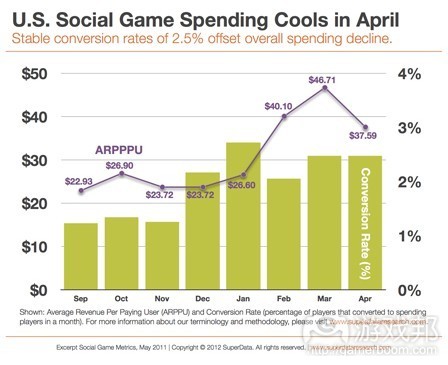每日观察:关注美国社交游戏付费玩家消费额下降(5.16)
1)SuperData最近报告显示,4月份美国社交游戏付费玩家平均在游戏中消费37.59美元,比2011年同一时期的45.58美元下降8美元。
尽管如此,总体付费玩家转化率却增长至2.5%,高于去年同期的1.4%。
中度硬核社交游戏玩家是当前主要消费驱动力;农场游戏玩家付费比例正在下滑,而策略及占半游戏付费玩家消费额却是前者付费用户的三倍。
预计2012年北美社交游戏市场规模为18亿美元,欧洲则是14亿美元。
2)据日经新闻报道,最近有传闻称日本社交网站Mixi首席执行官Kenji Kasahara最近准备出售55%自己持有的Mixi股票(游戏邦注:但Mixi随后发布简短声明否认了此事)。
观察者认为,从Mixi自去年秋季开始在日本一再向Facebook让步的情况来看,这个消息并不令人意外。在2011年9月至2012年3月之间,Facebook日本平台活跃用户已从500万增长至1000万;而Mixi月活跃用户至今停留在1500万左右,在最近几个季度中几乎没有增长。
Mixi于2004年上线,在2006年于东京证券交易所进行IPO,目前市值为3.26亿美元,比数年前大为缩水。
报道称日本社交游戏巨头DeNA和GREE很有可能竞价购买Mixi首席执行官所持有的股票,有观察者认为Yahoo Japan也有可能成为买家。比起GREE,Mixi同DeNA的关系“更为亲密”,两者在两个月前还合作推出了一个社交商务平台。
值得注意的是,Mixi很显然是一个手机社交平台,有80%以上的页面浏览量来自移动设备,它在智能手机平台的MAU也已经从去年7月的380万增长至今年3月份的700万以上。
相比GREE和DeNA,Mixi社交游戏运营表现并不乐观,这个实名制社交网站的用户好友多为用户在现实生活中的好友,它是一个“纯粹”的社交网站。
3)日本游戏开发商及发行商Marvelous日前成立了一个新社交游戏工作室Checkpoint Studios,其成员包括前索尼电脑娱乐、EA游戏元老,该工作室将由Brian Wiklem主导(他曾是索尼电脑娱乐、EAShiny Entertainment和Heavy Iron Studios等公司制作人),主要目标是开发跨平台社交游戏,并将于下个月向Facebook发布首款游戏《AviNation》。
Checkpoint还计划在今年利用Unity 3D引擎以及自己的Boomerang技术,向智能手机和平板电脑推出这款游戏。
4)据gamasutra报道,育碧最近表示他们认为掌机设备制造商应该关注飞速发展的社交游戏领域,尤其是免费增值模式,并在下一代掌机系统中植入这类功能。
该公司首席执行官Yves Guillemot表示,社交游戏所带来的发展机遇有助于扩大育碧的用户规模,增加ARPU(每用户平均收益),同时能够提升游戏品牌的创收潜力。
在线及数字业务已经成为育碧公司的一个重要组成部分,该公司在上一财年(截止今年3月份)通过这类游戏创收1.023亿美元,同比增长110.8%。
5)暴雪高管Jay Wilson在最近媒体采访中介绍了《暗黑破坏神3》这款游戏新功能“拍卖行”系统的特点,该系统支持玩家彼此用真钱交易道具,而暴雪则从道具贩售中抽成。值得注意的是,这个系统的理念是由暴雪设计师提出,而非出自运营团队的想法。
据其所称,暴雪从来不会脱离游戏设计需求而制定运营决策,他认为只要这种交易系统能够一举两得地让玩家和暴雪都获得好处,那么其设计理念就不存在什么问题(在此之前,玩家曾通过eBay或其他第三方网站进行道具交易)。
6)Insomniac Games首席执行官Ted Price在最近采访中透露,他们正在制作首款Facebook游戏《Outernauts》的毛绒玩具,但与《愤怒的小鸟》周边产品不同的是,购买这些毛绒玩具的用户可以在游戏中选择更多初始怪物角色(一般玩家在开始时只有5种怪物可供选择)。
据其所称,该游戏主要锁定13-25岁群体,含有许多RPG元素,将于今年夏季上线。
(本文为游戏邦/gamerboom.com编译,拒绝任何不保留版权的转载,如需转载请联系:游戏邦)
1)Social gamers spending less, but more converting to paying players
by Keith Andrew
Social gamers are becoming more comfortable with their surroundings, but that doesn’t necessarily mean they spend more in play.
That’s the finding of the latest monthly report delivered by SuperData, which claims the average paying social gamer in the US spent $37.59 in April.
That’s down $8 from the $45.58 each one on average parted with at the same point in 2011.
Up and down
Despite this decline, however, overall conversion rates into paying players have risen, with 2.5 percent spending in game.
That’s up from 1.4 percent a year previously.
“Mid-core social games are clearly driving the current momentum,” said VP of research Janelle Benjamin.
“This emerging genre represents a different gaming demographic that spends substantially more.”
A place to play
SuperData also notes a switch in the types of social games players are willing to spend in.
Farming games are on the decline, the firm reports, while strategy and combat games yield more than three times as much from paying users.
Region by region, the firm predicts North America will generate $1.8 billion in 2012, ahead of Europe on $1.4 billion.(source:pocketgamer)
2)Report: Mixi CEO Ready To Sell His 55% Stake, DeNA And GREE May Bid [Social Networks]
by Dr. Serkan Toto
Nikkei Business Online is reporting that Kenji Kasahara is ready to sell his 55% stake in Mixi (it’s not unusual for Japanese CEOs to hold such a large percentage of their companies, even after multiple rounds of funding and an IPO).
To make it clear: this is just a rumor at this point, and Japan’s largest real-identity social network just issued a one-sentence press release denying the report is true.
If true, this wouldn’t come as a big surprise. Mixi has been losing ground to Facebook at a fast clip since the fall of last year. Between September 2011 and March this year, Facebook Japan managed to double its active user base from 5 million to 10 million.
The active user base of Mixi is standing at 15 million MAU and hasn’t changed in the last few quarters.
Mixi was launched in 2004 and went IPO at the Tokyo Stock Exchange in 2006, as the world’s first “Web 2.0″ company. The company currently has a market cap of US$326 million (at /945am JST, the stock is up 7.4% currently) – just a fraction of what the company was worth a few years ago.
According to the Nikkei report, social gaming giants GREE and DeNA are likely to bid for the CEO’s stake in the company when the stock will be shopped around in the next few days.
Mixi is “closer” to DeNA than GREE. Just two months ago, the two companies opened a social commerce platform within Mixi together, for example (and there are more examples).
What’s interesting for both companies is that Mixi is clearly a mobile social network, as over 80% of their roughly 30 billion page views come through mobile devices. Another example: the number of smartphone MAU shot up from 3.8 million in July last year to over 7 million in March 2012.
Games on Mixi, however, have been a disappointment, financially speaking. Mixi managed to more than double sales coming from social games on their platform between Q4 of FY2010 and Q4 of FY2011 (like Facebook, the platform takes a cut from 3rd-party game providers). DeNA and GREE, however, are making more money in a few days through games than Mixi does in an entire financial quarter.
The biggest obstacle should be that Mixi has a different value proposition: Mixi offers a “tight” and real social graph (users usually have only a few dozen Mixi friends – and they are usually their friends in real life). It’s a “pure” social network, unlike GREE and Mobage (see here and here for how I outlined Mixi in the past).
If the report is true, I don’t think that Facebook would be interested. They are currently “winning” in Japan anyway.
Other companies that I can imagine looking at a possible Mixi deal are Yahoo Japan (the country’s biggest website offers many horizontal web services but failed miserably with social networks so far) or one of the country’s mobile carriers (which are getting more active in the content business as of late).(source:serkantoto)
3)Harvest Moon house Marvelous enlists U.S. startup for social game expansion
by Mike Rose
A newly-formed free-to-play studio, made up of former key staffers from big name companies such as Electronic Arts and Sony Computer Entertainment, is being funded by Japanese developer and publisher Marvelous as part of its international business strategy aimed at the rapid growth of social games.
The Costa Mesa, California-based Checkpoint Studios is headed by Brian Wiklem, who previously held producer roles at SCE, EA, Shiny Entertainment and Heavy Iron Studios. The studio is looking to develop cross-platform social games, and will release its first game AviNation next month via Facebook.
Checkpoint plans to then expand the aviation title, built using the Unity 3D engine and the studio’s own Boomerang technology, to smartphones and tablets later this year. (source:gamasutra)
4)Ubisoft seeks to capitalize on ‘social game benefits’ of next-gen consoles
by Eric Caoili
Though Microsoft and Sony haven’t revealed any details of their next-generation consoles to the public yet, Ubisoft says it’s preparing to take advantage of expected social game features in the platforms.
The publisher predicts that console makers have paid attention to the explosive growth and success of social games in recent years — particularly the free-to-play business model — and accommodated features from that space on their next-generation systems.
“Ubisoft is positioning itself to capitalize on the forthcoming arrival of the next generation of consoles which will be increasingly connected and will strongly boost the market thanks to a new qualitative leap and the integration of social games benefits and the item based model,” says CEO Yves Guillemot.
He continues, “These major opportunities will enable us to extend our global reach, increase our average revenue per user (ARPU) and therefore raise the profitability potential of each of our brands.”
The company also predicts strong growth in the free-to-play market for PCs, smartphones, and tablets. Guillemot says Ubisoft has prepared for future opportunities by ramping up the online expertise of its teams, as well as recruiting and acquiring talent with online experience (e.g. Howrse creator Owlient).
Ubisoft’s online and digital segment has become a critical segment for the company — it generated €80 million ($102.3 million) from sales in that category during it last fiscal year (ending March), an increase of 110.8 percent, thanks to free-to-play titles like The Settlers Online and Howrse.
David Polfeldt, managing director at the publisher’s subsidiary Ubisoft Massive, recently talked with Gamasutra about his expectations for next-generation consoles. He agreed with other developers that console makers need to make their platforms more open so studios can update their games on the fly, as they can with web and social games. (source:gamasutra)
5)Diablo III’s real money Auction House was driven by design team, says director
by Staff
Alongside today’s launch of Diablo III, Blizzard has introduced the series’ first ever official Auction House, where players can buy or sell items for real-world currency. With this new system, Blizzard will take a cut from each item sold, but despite the obvious financial gains, the game’s director says the Auction House came from the game designers, not the business side.
“[The new Auction House] came from the design department,” Diablo III director Jay Wilson tells Gamasutra in a feature interview, “Here’s one of the things that I will say — that no one in forums will believe me — but we never make business decisions outside of the game development team. We always make them based on what we think is right for the game.”
Wilson explains that designing a system that makes extra money isn’t a problem if it provides a real value to the consumer. If the players are happy and Blizzard is making money, it just means the studio can keep making bigger games, he says.
“I don’t think it’s a bad thing to want to make money. I think it’s a bad thing to want to make money off things that are not a good service or product for your customer, and that’s our inherent belief, is that it’s okay to make money on a service we provide for our customers that we think is a good service worth paying for.” Wilson explains.
“Do we want to make money off it? Of course we do, because we want to continue to make games, and we want to be successful. But we also think it’s a good service. We think it’s a thing players want, and want to do, and they want to be able to do it securely and easily, and they want to be able to make some cash off of it if they want. They want to be able to recycle that back into getting more items.”
The new Auction House made particular sense to the design team, Wilson adds, because Diablo II eventually developed its own consumer-run item economy, where players would buy and sell items through eBay or other third-party websites.
“The whole trade economy of Diablo II was a really interesting element of the game, but the game didn’t support it hardly at all. And so we looked at that and said that’s a real failing, and something we need to fix,” says Wilson.
Thus, the team built the Auction House directly into Diablo III, giving players the opportunity to sell their items in a secure environment that aims to limit scams and other illicit behavior.(source:gamasutra)
6)How will Insomniac’s Outernauts be the next Angry Birds? [Interview]
by Joe Osborne
“Actually, we’re making plush toys for this game,” Insomniac Games CEO Ted Price reveals. When Insomniac’s first Facebook game, Outernauts, launches this summer, so will a series of plushies based on the social game’s key characters. But unlike Angry Birds and more like Activision Blizzard’s Skylanders, these plush toys have a purpose.
“Basically, there are five different beasts that you can pick at the beginning of the game,” Outernauts designer Rowan Belden-Clifford elaborates. “Each of the plushies that we’ve made is one of the five starter beasts, so buying these is a way that you can get more starter beasts than the one you’ve chosen.”
The idea behind the push, Insomniac Games brand development director Ryan Schneider tells us, is to expand the game’s universe in a way that benefits the player in-game. Such a strategy has worked with Rovio’s seminal Angry Birds franchise–albeit with less cross-media flair–but the Finnish developer casts a much wider net than Insomniac looks to with Outernauts.
“I kind of see us going for myself as the audience–I’m 23 years old and I’m a console gamer primarily, but I’ve also been playing a lot of Facebook games over the past year or two,” Belden-Clifford admits. “And it’s something that I’ve seen a lot in my own friends group, starting to play Facebook games during lunch breaks at work and having as much enjoyment out of those as their favorite other games.”
In short, the studio has it sights on the 13 to 25-year-old demographic, an (perhaps slightly older) audience that developers Kixeye and Kabam have tapped rather successfully with their strategy-heavy war games on Facebook. But will a similar player base latch onto Outernauts and its plush toys? That depends upon whether the game packs fun and depth, ultimately.
Gallery: Outernauts on Facebook
“I think it boils down to bringing our console game experience to a new platform, and making a game that has real, core fun gameplay at the center of it,” Belden-Clifford says. “It’s something we’ve always been known for at Insomniac and I don’t think Outernauts is any different.” And to Price, that’s what will keep Outernauts in the backs of players’ minds this summer and beyond.
“I think number one is fun. You have to create an experience that’s entertaining, is engaging and keeps you thinking about the game frequently because of the story, the options that players have to continue improving whatever it is they have in the game. In our case, we have a lot of RPG [role-playing game] elements in terms of character evolution–the creatures that you capture. It’s a lot of fun to watch your creatures evolve, get stronger and earn new abilities. That’s one of the things that keeps me, as a player, coming back to the game.”(source:games)












































 闽公网安备35020302001549号
闽公网安备35020302001549号